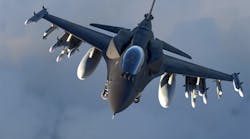Lockheed Martin Corp. proposed a new fighter aircraft design for the Indian defense forces, to be built in that country in collaboration with Tata Advanced Systems, an Indian weapons-systems integration company and a significant supplier to the Indian defense and security sector. According to reports, the F-21 fighter is in among the programs under consideration for an estimated $15-billion program to replace the Indian Air Force’s Soviet-supplied fighter aircraft.
A video released timed to the announcement at an Indian air show revealed single-seat aircraft empowered by an array of missiles and outfitted with advanced sensor technology. It would be available for air-to-air and air-to-ground combat. It’s not exactly “new” though—the rest of the world knows this plane as the F-16.
Reportedly the F-21 is based on the latest version of the F-16, the “Fighting Falcon,” which has been adopted by U.S. defense forces and those other nations. It’s understood that India previously rejected a proposal based on the earlier F-16 models.
According to Lockheed, the F-21 incorporates “common components and learning from Lockheed Martin’s fifth-generation F-22 and F-35 and will share a common supply chain on a variety of components.”
The F-22 is the single-seat, twin-engine tactical fighter aircraft with Stealth technology, widely known as the “Raptor.” The F-35 is Lockheed’s controversial (because of cost-overruns) Joint Strike Fighter aircraft, in service by the U.S. Air Force, U.S. Navy, and U.S. Marine Corps, as well as several allied nations.
“The F-21 is different, inside and out,” stated Vivek Lall, Lockheed Martin Aeronautics vice president of Strategy and Business Development, emphasizing the uniqueness of the proposal to the Indian customer.
It’s further reported that Lockheed proposed relocating its F-16 production plant from Fort Worth, Tex., to India. Then, it would export the aircraft built in India to overseas buyers.
Other suppliers contending for the Indian fighter jet program include Boeing Defense, Dassault Aviation, Eurofighter, Saab Group, and Russia’s United Aircraft Corp.
It said production in India would create thousands of jobs for Indian industry as well as support hundreds of U.S.-based Lockheed Martin engineering, program management and customer support positions.






